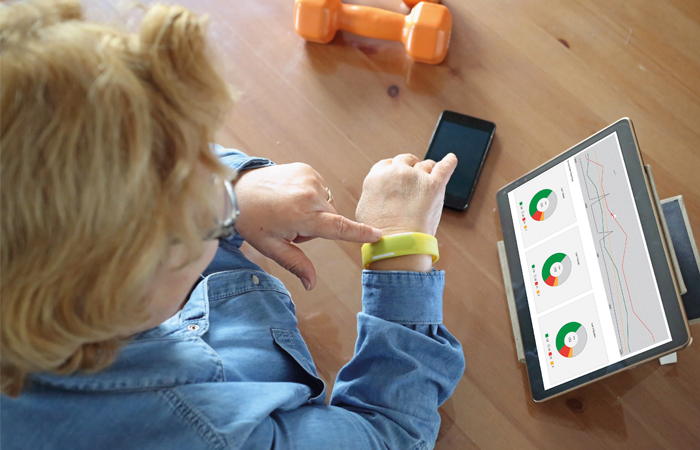Go, go gadget
In Conditions
Follow this topic
Bookmark
Record learning outcomes
Community pharmacies can offer customers self-diagnostic tests alongside a plethora of healthcare gadgets. So what opportunities do these advancements in technology provide for customers?
With huge advancements in technology in recent years, patients have more opportunity to conduct their own health checks and monitor their own health. The first finger-prick blood glucose meters for type 1 diabetes became widely available in the 1980s, and bluetooth-enabled glucose monitors linked to smartphone apps now make the self-management of diabetes even easier. More recently, there’s been an increasing use of wearable sensors to track vital signs, such as heart rate and abnormal rhythms, blood pressure and even blood oxygen saturation.

There’s a whole range of self-testing kits that empower patients to take more control over their own diagnosis and according to LloydsPharmacy pharmacist Pareena Patel, these kits tend to be popular with people who have busy lives as they “allow patients to test for health issues in the privacy of their own home without the need to see a doctor straight away”.
She adds: “They are straightforward and fast, allowing the patient to take control of their health and potentially removing any unnecessary worry. If used correctly, self-diagnostic testing kits can prompt patients to seek early medical attention. Patients are able to get a diagnosis quicker than having to wait for an appointment with their doctor to have an initial test. However, it is always recommended that patients have a follow-up appointment with their GP to confirm a diagnosis.”
The NHS Topol Review: Preparing the healthcare workforce to deliver the digital future, published in February 2019, revealed that 70 to 80 per cent of all clinical decisions rely on the results of a diagnostic test and if some of those can be done at home, there’s an opportunity to relieve some of the pressures on the NHS.
Cervical screening
The Department of Health and Social Care announced in January 2019 that it is considering plans to introduce a self-collection scheme for cervical screening, enabling women to collect their own samples. A recent survey revealed that many women delay or fail to attend screening appointments due to embarrassment and fear of being hurt and attendance at cervical smear tests in England is the lowest in two decades – as low as one in two young women in some areas of the UK. Now there is increasing evidence that self-collected samples are as accurate as those collected by healthcare professionals, and it is hoped that having this option will give uptake a welcome boost.
Pharmacy offering
Customers can access a wide variety of self-test kits in pharmacies, ranging from tests for cholesterol levels and stomach ulcers to bowel health and STIs. There are also kits to test for nutritional deficiencies, such as iron, vitamin D and vitamin B12, and to assess hormone levels in both men and women.
In April 2019, Boots UK launched a pilot scheme in partnership with online diagnostics service Medichecks, selling ten different tests through the Boots website. The results are posted back to a pathology lab and are interpreted by a qualified Medichecks doctor. Other tests are available in store and customers can book a consultation with the pharmacist to discuss the results.
Asif Aziz, director of pharmacy services at Boots UK, says: “Community pharmacy provides a safe environment for customers to talk to a pharmacist confidentially about any concerns they may be experiencing with their health or wellbeing. Pharmacists are able to have a complete care conversation with customers about their symptoms and give advice, or if appropriate, offer suitable over-the-counter options. Depending on the service being offered, pharmacists can sometimes supply prescription medication treatment under a patient group direction protocol, or via independent prescribing.”
In January 2019, Boots UK introduced its new Cystitis Test and Treat Service in 37 stores in London, Sheffield and Cardiff, for women aged 16 to 64 years. The service uses an innovative urine self-testing kit alongside a free smartphone app, which can analyse the sampled dipstick and display the results. After testing, the customer returns to the pharmacy to discuss the results, self-care advice and possible treatments.
“The Boots Cystitis Test and Treat Service will help to ensure that customers have fast and convenient access to appropriate treatment, based on their symptoms and the results of the test,” says Asif. “It will also help reduce the need for GP visits, freeing up clinician time and helping to reduce cost across the NHS. The combination of convenient testing and a discussion with a pharmacist, will assist with the appropriate supply of antibiotics which, in turn, will help to combat the rise of antibiotic resistance.”
Testing advice
Pharmacy teams are well placed to help customers buy the right self-testing kit to suit their needs and preferences. “Customers look for tests that are easy to perform at home and provide reputable results,” Pareena says. “This is important as it allows the patient to comfortably perform the test without help. In addition, using accurate tests that are able to diagnose specific symptoms and are fast and reliable, giving results that are easy to interpret, is important. The tests must be cost effective and free of equipment so the customer doesn’t need to buy any additional items to carry out the test.”
Reputable self-testing kits should contain a patient information leaflet with in-depth, simple instructions, and some are supported by step-by-step instructions via an app. However, customers may still need one-to-one advice. “Pharmacy teams should have a consultation with patients to go through the individual test required and how to interpret the results,” Pareena explains. “Incorrect interpretation of results could lead to unnecessary worry for the patient or, equally, may cause the patient to think there isn’t a need for them to seek medical advice.”
Some devices use smart technology to connect with apps
Encouraging testing
One in eight people living with HIV in the UK remain undiagnosed, even though the infection has become manageable in recent years. In August 2018, Superdrug became the first large high street retailer in Britain to sell HIV self-testing kits in over 200 stores and Boots UK started stocking the tests in 813 stores and online from 29 April 2019. The BioSure HIV Self Test, which has a 99.7 per cent accuracy rate, is also available from online pharmacy retailers and the Terrence Higgins Trust sells low-cost BioSure kits to high-risk individuals, with free testing kits available to those who can’t afford them. It should also be noted that free testing is still available from sexual health clinics.
Jaime Perkins, UK sales director at BioSure (UK) Ltd, says that the HIV Self Test will hopefully encourage more people to get tested or more people to test regularly. “No clinic, appointments or queues are needed, and it’s convenient and private, providing the same reliable results as testing with a clinic. A perfect analogy is pregnancy testing,” he says. “To help pharmacy staff provide the correct advice, we have produced an information fact sheet for pharmacy staff to advise about how the test works, its limitations, who it’s appropriate for and why it’s important.”
The BioSure Self Test features clear instructions inside the pack. Customers who are concerned about their risk of HIV – whether a test is negative or positive – should be encouraged to seek advice from their GP, a sexual health clinic or the Terrence Higgins Trust. “Our key message is that if there’s a positive result, it’s important to get this confirmed, along with medical advice. HIV is a treatable condition and people are living with a positive diagnosis. There is also a strong message about staying negative if the result is negative, which involves minimising the risks, such as using condoms,” says Jaime.
Diagnostic devices
Pharmacies can also stock, and advise on, blood pressure and glucose monitors, although these devices should be used alongside, rather than in place of, regular health check ups. As with testing kits, pharmacy staff need to ensure that customers are buying the right products to suit their specific needs. Any customers with concerns about their blood pressure or blood sugar levels should contact their GP surgery, even if they have already received a formal diagnosis. Some devices use smart technology to connect with apps, so that they can easily forward their results to their GP or clinic.
“Home-use blood pressure monitors enable regular monitoring in a more relaxed setting than the doctor’s office, help improve engagement in the treatment and allow people to assess day-to-day blood pressure variability,” says Charlie Fox, sales director at Omron Healthcare. “Customers should look for clinically-validated devices that fit their specific condition. For example, there are now clinically-validated blood pressure monitors for use in the obese population, pregnant women and diabetic patients, which have been designed to meet the challenge of getting accurate readings within these particular demographics.”
Customers should be advised to read the manual carefully before using the devices, as the instructions and collating of the results varies. “By and large, people have to follow certain rules in order to make sure their results are being properly measured,” says Charlie. “They are advised not to drink alcohol or caffeine at least 30 minutes before taking their readings, and rest for at least five minutes before taking their blood pressure. If they are using a table device, they need to make sure they are sitting with their feet touching the ground and the angle below their knees at 90 degrees. The elbow must rest on a table and the cuff should be placed at least one finger above the elbow line. Wrist-type devices require the user to raise the device up to the level of their heart.”
Activity trackers explained

Many people now use an activity tracker to monitor their daily step count, either through a wearable device or their smartphone. There’s some evidence that activity trackers can encourage more physical activity, especially in people who lead largely sedentary lifestyles. Some trackers also measure heart rate and sleep patterns and may enable people to input their calorie intake via an app.
Activity trackers can give people more awareness about their overall health and fitness, encouraging them to share goals or even compete against themselves or others. Pharmacy staff are ideally placed to offer advice on making positive lifestyle changes, such as stress relief, sleep hygiene strategies, healthy eating and being more active.
According to Rhys Thatcher, reader in exercise physiology at the Institute of Biological, Environmental and Rural Sciences (IBERS) at Aberystwyth University, activity trackers do vary in accuracy, but this isn’t that important when considering their health benefits. “Activity trackers definitely have a role to play in improving health. We all like to see ourselves progress,” Rhys says. “You have to interpret the data coming out of them with care – they are not direct measurements. However, they can be useful to compare what you’re doing today with what you did yesterday, what you’re doing this week compared to last week, so you can see progression. That can be a great motivational tool to help people to stick to an exercise programme.”
